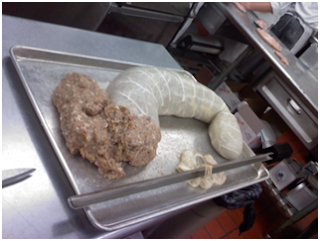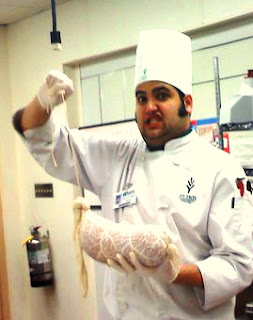This is the experience of the Garde Manger Class at Ivy Tech Community College of Central Indiana.
Tuesday, November 30, 2010
Smoking and Curing
Monday, November 22, 2010
Stacked
In class today we studied the making if sausages and we also looked at the final product from session three terrines. As a whole we learned several things about our terrines. In two of the groups the terrines where baked in a route. We learned that if the stack hole was not large enough or if there is not a stack hole at all there will be separation of the terrine and the croute. This was the case in one of our terrines as the stack hole was not large enough and the steam could not escape causing the terrine to rise and leave a gap at the bottom of the terrine dish. We also learned as we where cutting and tasting our terrines that if you use vegetable you should put them in the oven to draw out some of the moisture. This would help make the terrine a little dryer and make it more stable. One of the best things that I learned is if your terrine is under seasoned or over seasoned it cannot be used. This I learned because one of my group’s terrines was over salted, even though it had a very good flavor this item could not have been served on a platter for a buffet. When doing terrines we learned that there are several steps that must be taken even though it is not in the recipe if these steps are followed you will have a much better product turn out of your hard work.
To continue with session four we prepped sausage to grind and stuff. Even though only one group managed to stuff a sausage, I think the biggest thing we learned as a class is that time management is very crucial during our production. I think we did however learn some very useful information in this session. We did learn that the making of sausage is not a one day job, because most of the sausage will have to cure for several weeks if not months. We learned that sausage can be made from several different animals and can be stuffed in many different ways as well as different products with the natural animal casings being the best. In closing I would have to say the one thing I learned the most was on my buffet presentation, this meaning the flow of my food from the ladder to its overall presentation cannot just be thrown together at the last minute it really needs some thought put in to it to make it more appealing to the eye especially for you potential customers.
Thursday, November 18, 2010
Temptation
 Day 3 of the two by eight Garde Manger class for the Fall Semester, and we’re already off and running. Without even missing a beat from two mystery basket tests, we tear (and puree and even grind) into what I consider the “meat” of Garde Manger, the Pate d’Terrine. When I saw the listings on day 1, I knew that I had to have this as my day, just for how important I view the use of forcemeats in my culinary life.
Day 3 of the two by eight Garde Manger class for the Fall Semester, and we’re already off and running. Without even missing a beat from two mystery basket tests, we tear (and puree and even grind) into what I consider the “meat” of Garde Manger, the Pate d’Terrine. When I saw the listings on day 1, I knew that I had to have this as my day, just for how important I view the use of forcemeats in my culinary life.As soon as we got settled into class, and the presentation had ended, the entire class just kicked into high gear, immediately moving to the cart and working on getting their pates and terrines (and even moussalines, depending on what was going on) ready for placement in the ovens and to sit overnight. While this was the core of today’s class, we still had to prepare the family meal for ourselves and our comrades-in-arms, the Baking Science students in the adjoining lab.
Unfortunately, that’s where we had our little hiccup. With such focused determination on not wanting our pates to break, to get them in the oven on time, the concept of family meal fell a little on the back burner. Even still, after a 15 minute extension, and a little cajoling, we got that plated up, with all pates in the oven. The threat of staying till midnight averted. Once again, we prove ourselves to be the stuff of the upper-level culinary students, cleaning our stations as we went, and making sure that our dishes weren’t piled up. Even with a little hiccup, we’re able to be clean at all times.
Overall, the class performed admirably, and as the forcemeats went into the ovens, and later the blast chiller, I’m left thinking, why do I have to wait until tomorrow to taste the final product? What’s the old saying? Good things come to those who wait. I can already taste it.
For me, pates are always worth the wait.
Monday, November 15, 2010
Amuse
AH! Amuse, like a crayon to a child or paint to an artist, food comes to the crafty chef with many elements to “ Amuse’ or tickle the fancy of the culinist foodie.
Yes let’s feast our senses with sight and smells and to tantalize our taste buds with the fabulous colors and textures that do delight the eye as well as the palate. It’s also very challenging because it has no real boundaries besides being a bit or two. Where as a meal contains the same elements but the amounts are larger and follow a theme. The chef can keep from being bogged down because it’s a tiny morsel to please and is really so simple. As well as all that it’s very economical to work with. A pound of protein and a hand full of idea’s we can be on our way to pleasures we can share with each other.
Amuse also causes a reset of how we think of food. Forget heavy and know that light is king.
In thinking what we do with leftovers, let’s make Amuse. Besides how many uses of leftovers are there?
I can’t stress enough that the freshest ingredients are the most important but still allows us to raid the refrigerator for goodies and ideas.
One problem I discovered was experience goes a long way so it’s time to open our imagination.
Amuse, the Magic Lamp of the creative chef.
Reggie Osbourne
Garde Manger
The students of Ivy Tech Community college take a 16 session class studying Garde Manger. Classically the Garde Manger person in a kitchen would be somene that takes care of all cold food, charcuterie and butchery.
The students were asked to write a statement about what they learned in class so that it could be posted to this site.
Enjoy
The students were asked to write a statement about what they learned in class so that it could be posted to this site.
Enjoy
Subscribe to:
Comments (Atom)


